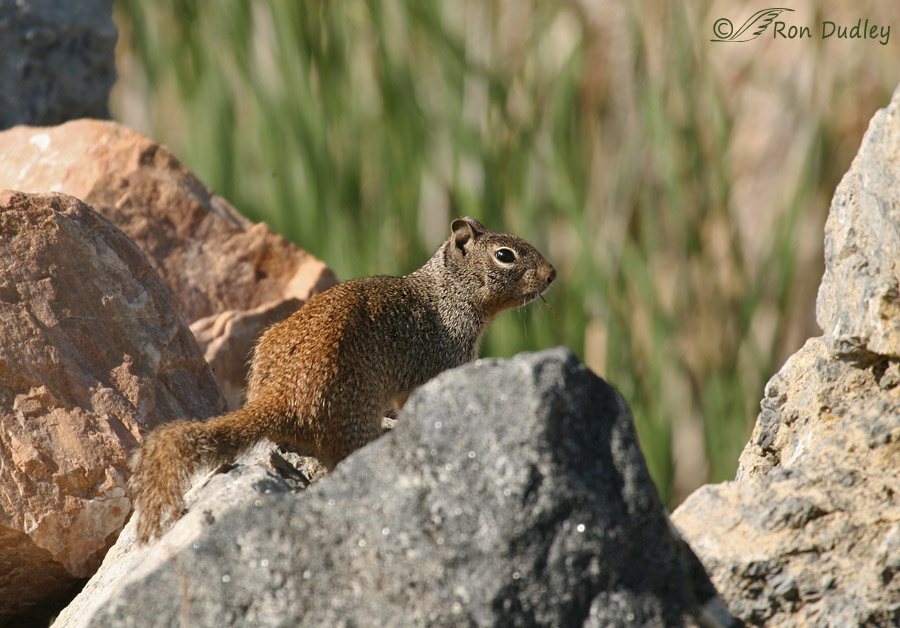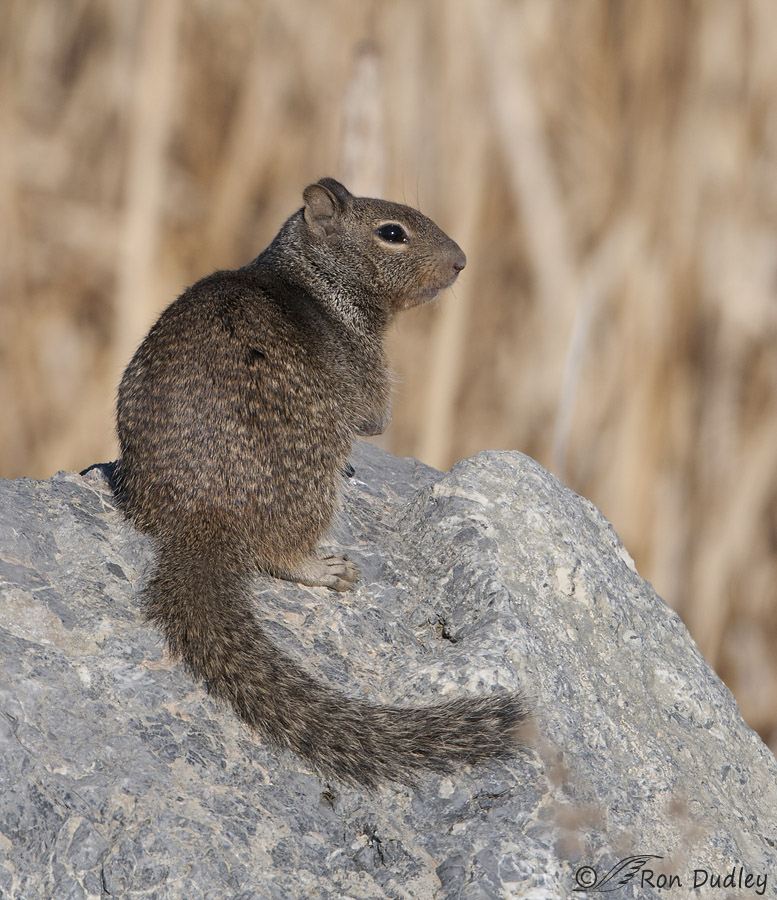Today’s post is a change of pace for me involving Rock Squirrels, my own ignorance about my subjects and my evolution as a nature photographer.
A recent conversation with Mia brought up the subject of Rock Squirrels, a species that I was unaware of which embarrasses me a little because they’re apparently common in much of the southwestern U. S (including parts of Utah) and as the largest ground squirrel within their range they’re physically conspicuous. The conversation brought back memories of some of the earliest nature photographs I ever took – images of some kind of squirrel I encountered at Farmington Bay WMA seven years ago. I never did identify the species of squirrel and had forgotten about the images until a few days ago. So I went rummaging around in an old computer until I found them. Sure enough, they were Rock Squirrels.

1/400, f/7.1, ISO 200, Canon Rebel XIi, Canon EF100-400mm f/4.5-5.6L IS USM @ 400mm, not baited, set up or called in
I photographed this squirrel on May 6, 2007 in the rocks lining one of the ponds at Farmington. I remember being surprised at how large it was (length 16 – 20″ and wt. about 1 1/2 lbs) and by its long, relatively bushy tail (for a ground squirrel). This species more closely resembles typical tree squirrels than it does typical ground squirrels.
I looked for these squirrels every time I visited Farmington that summer and never found one again until…

1/640, f/13, ISO 400, Canon Rebel XTi, Canon EF500mm f/4L IS II USM, not baited, set up or called in
5 1/2 months later (Oct. 21, 2007) when I encountered this one in the same area as the first squirrel. I estimate that I’ve visited Farmington between 500 and 600 times since the summer of 2007 and I’ve never seen one there since (or anywhere else for that matter, that I’m aware of).
For several reasons these photos remind me of my development as a photographer. The first image was actually taken as a JPEG rather than shot in RAW. It’s been so long since I’ve shot in JPEG that I’d forgotten about the angst I went through when I was trying to decide whether or not to switch over to RAW. Man, I’m glad I made that switch early in my “career”, even though learning to process RAW files was a bit of a struggle for a while. Last night I actually winced when I realized that I was going to have to process a JPEG for this post. I also winced a little when I noticed my camera settings for these photos – they’re not what I’d choose today.
These images (and their subject) may not hold much interest for some but for me they were a trip down memory lane.
Ron


What settings would you choose today for these shots? I’m still having trouble deciding correct settings.
Deedee, Today I never use/need ISO’s as low as 200. I prefer more shutter speed instead, for a variety of reasons. My default ISO is 500 with my 7D – it handles noise perfectly well at that setting though above 640 noise begins to become a problem.
One of my favorite critters. We see them fairly frequently at Hueco Tanks, and two days ago we had an encounter with one that almost gave both me and the squirrel a heart attack. It was racing through the brush up to where we were walking on a path, and all of us put on the brakes. The squirrel went down the path a little way, and stopped in a very alert state with its tail straight up. My husband had his video camera going, and when he started talking to the squirrel, immediately the tail started to come down, as the squirrel relaxed. When it walked further, it was at a normal squirrel pace. I know this anecdotal evidence, but at least for us it confirmed the value of talking to animals when we encounter them. I was surprised to hear that they are ground squirrels, because the ones we see all have the fluffy tails of tree squirrels. The difference between your two photos is quite noticeable. Clearly you learned a lot in a short time.
Fascinating stuff, Susan. I’ve also had the experience where talking to critters in a soft voice seemed to calm them. I’ll bet that video would be interesting to watch…
We moved to southern California from Texas in 1990 and these are the “spotted” squirrels we have in our yard. I have told folks at Tucker Wildlife Sanctuary about them because their squirrels are different than mine. They have tree squirrels. They seemed surprised by my description and I had not pursued finding out what they were so I am happy to see this post. We have inherited many more squirrels from the Great Sports Park of Lake Forest construction near our home. All the critters who lost their habitat have come to our yard and are welcome here. Some of the Cactus Wren were successfully relocated in Laguna Canyon. I always, always learn from you and pass your info along to everyone. This is my absolute favorite nature site! Thank you Ron!
Your comment made my day, Phyllis. Thanks for that!
How I have missed the wonders you give us each day. Hopefully in a week or so I will be able to get my daily fix again.
Thank you for taking us wandering down memory lane with you.
And we have missed you, Elephant’s Child. Thank you.
Please come visit me in Lancaster, PA if you want to shoot squirrels. I probably have over a dozen in my yard on any given day. They eat all the bird food and chestnuts and egg corns and dig holes everywhere. They are yours for the asking!!!
You folks back east have a lot more of the tree squirrels than we do, Ellen.
Don’t apologize, there is nothing wrong in taking mammal shots and these shots are fine!
I have to admit that your weasel shots are what first got me interested in your blog even though I am a birder! I thought those where the finest bit of photography I had seen and was very envious that you had the chance to catch the ermine in such great poses. I think I have seen a weasel twice in my life time and those views were fleeting, so your shots were a delight for me.
Your Rock Squirrel is fine, plus I have never seen a Rock Squirrel, so the picture plus the information is an eduction for me!!
I had the same quandary about JPG and RAW, but moved to RAW on all my nature shots and leave it at JPG for family shots. For me it is the space on the computer that RAW requires. But, oh what you can do with a shot taken in RAW as compared to JPG.
“But, oh what you can do with a shot taken in RAW as compared to JPG.”
That says it all, doesn’t it, Dick?
Thanks for remembering my weasels. I don’t see them often either but I sure do look for them. There’s a few spots at Farmington and on Antelope Island where I’ve photographed them before and I can’t go by those spots without looking for them again. But they’re so vagrant and elusive that it’s rare that I even see them, much less get a photo of one.
Great shots and interesting info.
Charlotte
Thank you, Charlotte.